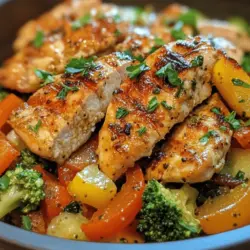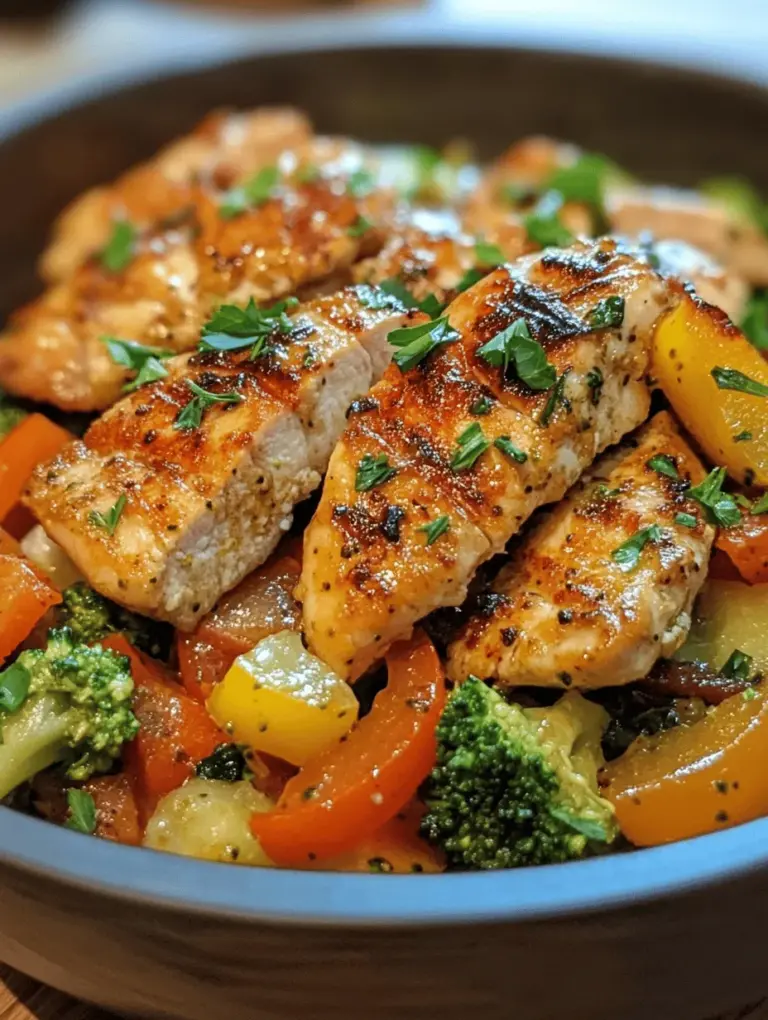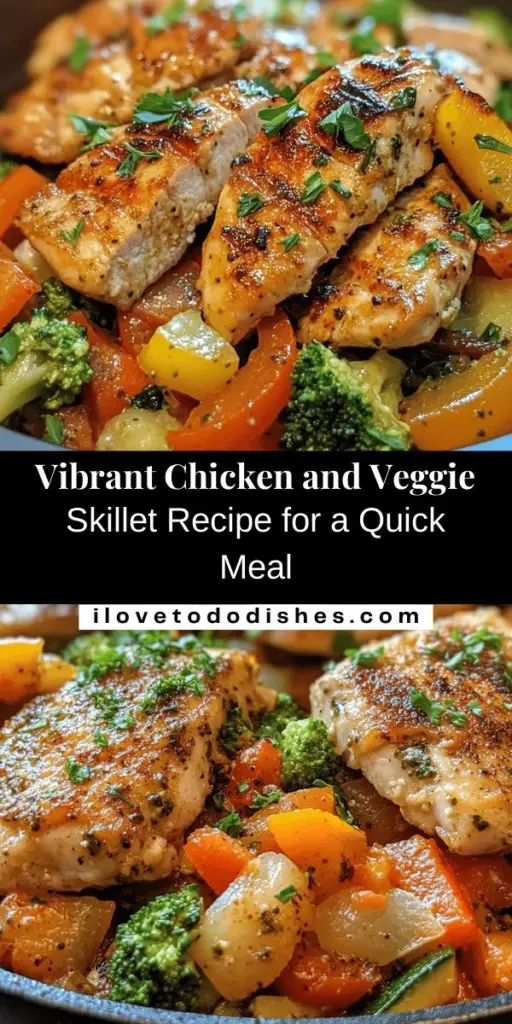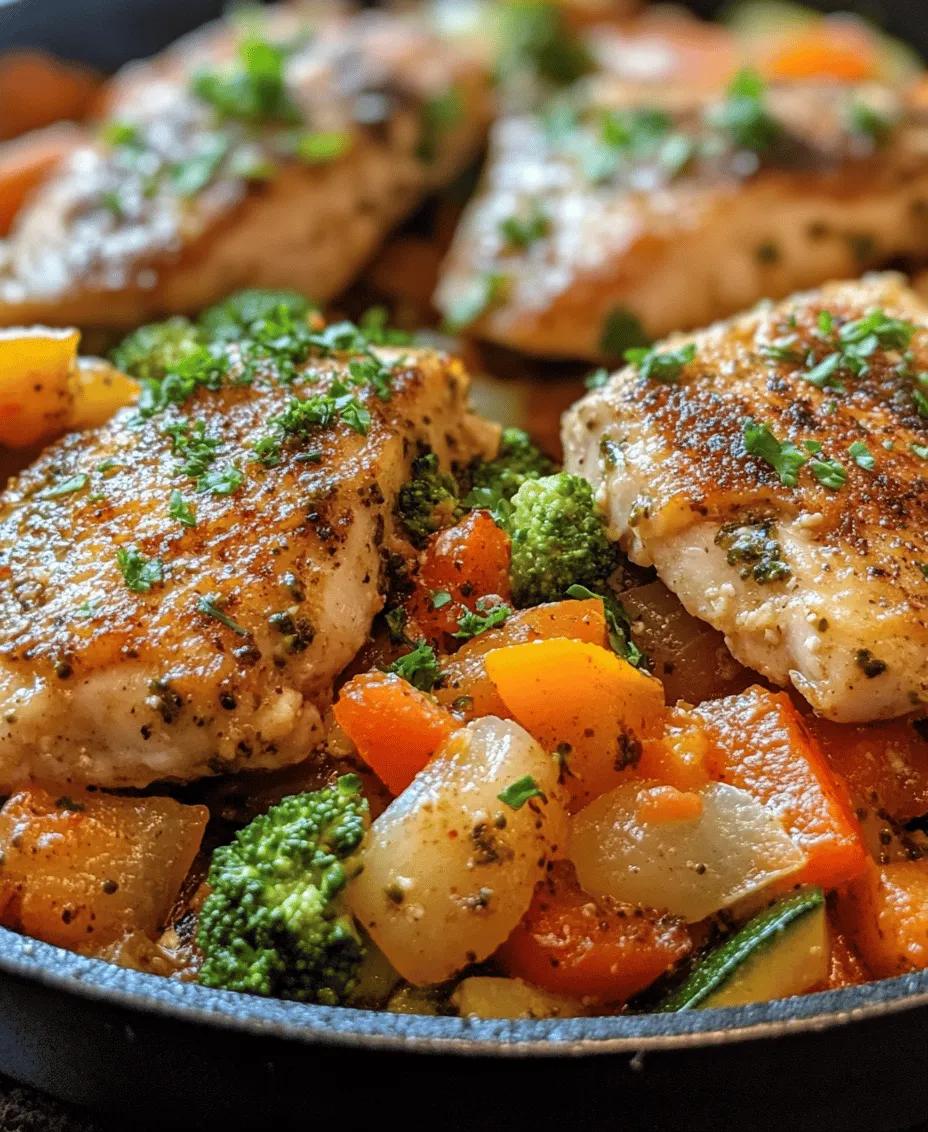Introduction
In the world of cooking, few dishes can boast the vibrant appeal of a colorful chicken and veggie skillet delight. Not only does this recipe tantalize the taste buds, but it also serves as a visual feast, showcasing a rainbow of fresh vegetables alongside tender, juicy chicken. This dish is perfect for anyone looking to whip up a quick weeknight meal that doesn’t compromise on nutrition or flavor. Its easy preparation makes it suitable for both novice cooks and seasoned chefs alike, allowing you to create a wholesome meal in just one skillet.
A colorful meal is more than just a treat for the eyes; it’s a vital component of a balanced diet. Eating a variety of colors in your meals typically indicates a range of nutrients. Different colors in fruits and vegetables signify the presence of various vitamins, minerals, and antioxidants, all of which contribute to overall health. By incorporating an array of vegetables into your skillet dish, you not only enhance its appearance but also boost its nutritional profile.
Cooking with fresh ingredients elevates any recipe, bringing out the natural flavors of the food while ensuring that you consume fewer preservatives and additives. This approach not only supports better health but also aligns with sustainable eating practices, as seasonal and local produce often tastes better and is more environmentally friendly.
In this article, we will delve deep into the essentials of preparing a colorful chicken and veggie skillet delight. From understanding the key ingredients to mastering the preparation steps, every aspect of this recipe is designed to make your cooking experience enjoyable and successful.
Understanding the Ingredients
To create a delicious and visually appealing skillet dish, it’s crucial to use high-quality ingredients. Let’s explore the main components of this colorful recipe, including chicken, a variety of vegetables, olive oil, and herbs and spices.
Chicken Breast: Nutritional Benefits and Cooking Tips
The star of this dish is undoubtedly the chicken breast. Known for its lean protein content, chicken breast is an excellent choice for those looking to maintain a healthy diet. Each serving provides ample protein, which is essential for muscle repair and growth, making it an ideal ingredient for active individuals. Additionally, chicken breast is low in fat, particularly when the skin is removed, which helps keep the calorie count down.
When it comes to cooking chicken, achieving that perfect golden-brown exterior while keeping the meat juicy inside is key. To do this, it’s essential to start with a well-heated skillet and to avoid overcrowding the pan. Overcrowding can cause steaming rather than searing, preventing that desirable crust from forming. A simple seasoning of salt and pepper can go a long way, but don’t hesitate to experiment with garlic powder, paprika, or even a squeeze of lemon juice for added zest.
Vegetables: A Breakdown of Each Vegetable’s Health Benefits
The beauty of this skillet delight lies in its vibrant vegetables. Each vegetable not only adds color but also brings its own health benefits:
1. Bell Peppers: Rich in vitamins A and C, bell peppers are known for their antioxidant properties. They contribute to skin health and immune function.
2. Zucchini: Low in calories and high in water content, zucchini is excellent for hydration. It also contains potassium, which is vital for heart health.
3. Carrots: Packed with beta-carotene, which converts to vitamin A in the body, carrots support vision and skin health. They also provide dietary fiber, aiding in digestion.
4. Broccoli: This cruciferous vegetable is a powerhouse of nutrients, including vitamin K, vitamin C, and fiber. Broccoli has been linked to reduced inflammation and improved heart health.
5. Spinach: A leafy green known for its iron content, spinach is also rich in vitamins E and C, which help fight oxidative stress in the body.
By incorporating a variety of vegetables into your dish, you not only enhance the flavor but also ensure a wide range of nutrients that support overall health.
Olive Oil: Importance of Healthy Fats in Cooking
When it comes to cooking oils, olive oil stands out as a heart-healthy option. Rich in monounsaturated fats, it promotes good cholesterol levels and offers anti-inflammatory properties. Olive oil is not just a cooking medium; it also enhances the flavor of your dish, making it a staple in Mediterranean cuisine.
For this skillet recipe, using extra virgin olive oil will provide a robust flavor that complements the freshness of the vegetables and the seasoning of the chicken. When heating olive oil, be mindful of its smoke point—excessive heat can lead to the oil losing its beneficial properties. Opt for medium to medium-high heat when sautéing, allowing you to achieve the desired crispness without compromising the oil’s quality.
Herbs and Spices: Enhancing Flavor Without Extra Calories
Herbs and spices are essential to elevating the taste of any dish without adding unnecessary calories. In this colorful chicken and veggie skillet delight, consider using fresh or dried herbs such as basil, thyme, or oregano. These herbs add depth and complexity, making each bite more flavorful.
Spices like paprika, cumin, and garlic powder can also be incorporated to create a more robust flavor profile. Don’t be afraid to experiment with different combinations to find the perfect blend that suits your palate. The key is to season gradually, tasting as you go to ensure the flavors meld beautifully.
Preparation Steps for Success
Success in the kitchen often begins with careful preparation. This section outlines the steps necessary to ensure that your colorful chicken and veggie skillet delight is a hit.
Prepping the Ingredients
Before you dive into cooking, take the time to properly prepare your ingredients. Start by gathering all the necessary items—this includes your chicken, vegetables, olive oil, and any herbs and spices you plan to use. Having everything on hand will streamline the cooking process and reduce the likelihood of forgetting key components.
Uniform cutting of your vegetables is important for even cooking. Aim to chop your bell peppers, zucchini, and carrots into similar-sized pieces to ensure that they cook at the same rate. For example, if you slice your carrots too thickly, they may take longer to soften than your other vegetables, leading to an inconsistency in texture.
Tips for Washing and Handling Vegetables Safely
Proper washing and handling of vegetables is crucial to food safety. Start by rinsing all fresh produce under cold running water to remove dirt and potential pesticide residues. For leafy greens like spinach, consider soaking them in a bowl of water to allow any grit to settle at the bottom. After washing, be sure to dry your vegetables thoroughly to avoid excess moisture in the skillet, which can lead to steaming rather than sautéing.
When handling raw chicken, always prioritize hygiene. Use a separate cutting board for meat to prevent cross-contamination, and wash your hands, utensils, and surfaces thoroughly after handling raw poultry.
Cooking the Chicken
With your ingredients prepped, it’s time to cook the chicken. Heat a drizzle of olive oil in a large skillet over medium-high heat. Once the oil is hot (but not smoking), add the seasoned chicken breast. Allow it to sear without moving it for several minutes until it develops a golden brown crust. This process not only enhances flavor through the Maillard reaction but also helps to lock in moisture.
Flip the chicken and reduce the heat to medium. It’s crucial to monitor the internal temperature, ensuring it reaches 165°F (75°C) for safe consumption. A meat thermometer is a handy tool to have on hand, offering accuracy and peace of mind. Once cooked, remove the chicken from the skillet and allow it to rest for a few minutes before slicing. This resting period helps redistribute the juices, keeping the meat succulent.
Techniques for Achieving a Golden Brown, Juicy Chicken
To achieve that coveted golden-brown crust, consider these additional tips:
– Pat the chicken dry: Moisture on the chicken’s surface can prevent browning. Use paper towels to pat the chicken dry before seasoning.
– Avoid overcrowding: Cook in batches if necessary. Placing too much chicken in the skillet at once will lower the temperature and lead to steaming rather than searing.
– Use a cast iron skillet: If you have one, cast iron pans are excellent for browning due to their heat retention properties.
Seasoning Options to Enhance Flavor Profiles
When it comes to seasoning the chicken, simple can be effective. A blend of salt, pepper, garlic powder, and a pinch of paprika can enhance the dish without overpowering the natural flavors. For a more adventurous profile, consider marinating the chicken in a mixture of olive oil, lemon juice, and your favorite herbs for a few hours before cooking. This not only infuses flavor but also tenderizes the meat, making it even more delicious.
Sautéing the Vegetables
Once your chicken is cooked and resting, it’s time to sauté the vegetables. This step is critical to achieving the right textures and flavors in your colorful dish.
Importance of Cooking Times for Different Vegetables
Different vegetables have varying cooking times. To achieve a perfectly sautéed mixture, start with the vegetables that take the longest to cook, such as carrots and broccoli. Add these first and allow them to soften for a few minutes before adding quicker-cooking vegetables like bell peppers and zucchini.
Crisp-Tender vs. Fully Cooked: Finding the Right Balance
The goal of sautéing vegetables is to create a crisp-tender texture. This means that the vegetables should be cooked enough to soften but still retain a slight crunch, providing a satisfying bite. Overcooked vegetables can become mushy and lose their vibrant colors, diminishing the visual appeal of your dish.
As you sauté, keep an eye on the colors and textures of the vegetables. A quick toss in the skillet will ensure even cooking, and a splash of water or broth can help steam them slightly without losing their crispness.
By following these preparation steps and understanding the ingredients, you’re well on your way to creating a vibrant, healthy, and delicious colorful chicken and veggie skillet delight. The next part of the article will delve deeper into the final cooking steps and tips for serving this delightful dish.
Enhancing Flavors Through Garlic and Seasoning
The heart of any delicious meal lies in its flavors, and in the case of the Colorful Chicken & Veggie Skillet Delight, garlic and seasoning play a pivotal role. Garlic not only adds an aromatic depth but also infuses the dish with a savory umami flavor that complements the natural sweetness of the vegetables. To enhance the flavor profile, consider using fresh minced garlic instead of garlic powder, as the fresh variety will provide a more robust taste.
When it comes to seasoning, a careful blend of salt, pepper, and spices can elevate this dish to new heights. A sprinkle of smoked paprika or Italian seasoning can introduce a warm, earthy flavor, while a touch of red pepper flakes can add a subtle kick for those who prefer a little heat. Always remember to taste as you go; this will help you achieve the perfect balance of flavors.
Combining Ingredients for Maximum Flavor
To create a harmonious and flavorful dish, the order in which you combine your ingredients is crucial. Start by sautéing the garlic in olive oil until fragrant but not browned, as burnt garlic can introduce a bitter taste. Next, add the chicken pieces, allowing them to sear and lock in juices. This step is essential for building layers of flavor.
Once the chicken is almost cooked through, introduce your colorful array of vegetables. Bell peppers, zucchini, and carrots should be added first since they require a bit longer to become tender. The vibrant colors will not only make your dish visually appealing but also provide various nutrients. After a few minutes of cooking, stir in the spinach—this leafy green cooks quickly and should be added towards the end to maintain its bright green color and nutritional value.
Another crucial element in enhancing flavors is the use of acids. Lemon juice and balsamic vinegar are fantastic additions to brighten the dish. A splash of lemon juice just before serving can add a refreshing zing, while balsamic vinegar, drizzled over the top, introduces a tangy sweetness that complements the chicken and veggies beautifully. The careful layering of these ingredients ensures a cohesive flavor throughout the skillet dish.
Serving Suggestions
Once your Colorful Chicken & Veggie Skillet Delight is ready, presentation becomes key in making the meal appealing. Consider serving this dish in a large, shallow bowl to showcase the vibrant colors of the chicken and vegetables. You can garnish with fresh herbs such as parsley or basil for a pop of green and a fresh aroma.
For a well-rounded meal, think about pairing the skillet dish with grains. Quinoa, brown rice, or whole wheat pasta work wonderfully as bases, providing additional fiber and nutrients. These grains can soak up the delicious juices from the skillet, making every bite satisfying.
To add visual aesthetics, consider plating the dish with a colorful side salad, perhaps featuring mixed greens, cherry tomatoes, and thinly sliced cucumbers, dressed lightly with olive oil and vinegar. This not only enhances the meal’s presentation but also contributes to a nutritional balance that includes greens, proteins, and whole grains. Aim for portion sizes that are satisfying yet mindful, keeping in mind the balance of carbohydrates and proteins in your plate.
Exploring Variations and Customizations
One of the most enjoyable aspects of cooking is the ability to customize recipes to suit your taste preferences or dietary needs. For those looking to explore protein alternatives, tofu, shrimp, or turkey can easily replace the chicken in this skillet dish. Tofu marinated in soy sauce or teriyaki can infuse the meal with a delightful Asian flavor, while shrimp offers a light and quick-cooking option.
When it comes to vegetables, don’t hesitate to swap in seasonal ingredients to keep your dish fresh throughout the year. Asparagus, broccoli, or even sweet potatoes can be wonderful additions, depending on what’s available. Additionally, if you want to introduce different cuisines, consider adding spices like curry powder for an Indian twist or hot sauce for a Mexican flair. The versatility of this dish makes it easy to adapt and experiment with various flavor profiles.
Health Benefits of the Colorful Chicken & Veggie Skillet
This Colorful Chicken & Veggie Skillet Delight is not only a feast for the eyes but also a well-balanced meal that delivers numerous health benefits. Incorporating a variety of colorful vegetables ensures that you are getting a range of essential vitamins and minerals. Each color represents different nutrients; for instance, orange carrots are rich in beta-carotene, while leafy greens like spinach are packed with iron and calcium.
Eating a balanced meal, featuring protein, healthy fats, and complex carbohydrates, contributes to overall well-being. This dish aligns with dietary guidelines by providing lean protein from chicken, fiber from vegetables, and whole grains if paired appropriately. Furthermore, the inclusion of a variety of colors on your plate is known to support a healthy lifestyle, as it encourages a diverse intake of nutrients.
Conclusion
In summary, the Colorful Chicken & Veggie Skillet Delight is a perfect example of how simple ingredients can come together to create a delicious and nutritious meal. Its vibrant colors and robust flavors not only make it appealing but also serve as a reminder of the joy of cooking with wholesome ingredients.
We encourage you to enjoy the process of cooking, experimenting with various flavors, and discovering what works best for you and your family. Sharing this delightful dish with loved ones can turn an ordinary dinner into a festive gathering, creating lasting memories over a shared meal. Happy cooking!



